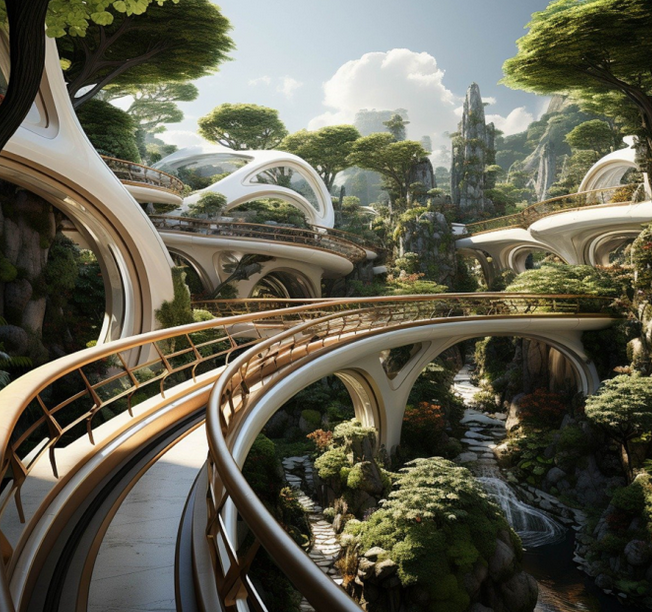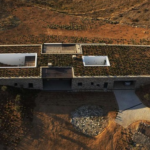Biomorphic design principles centre on the integration of natural forms, patterns, and processes into architectural creations. Drawing inspiration from the diverse shapes, textures, and systems found in nature, biomorphic designs seek to emulate the efficiency, elegance, and resilience of the natural world. In this exploration, we delve into the foundational principles that guide biomorphic design, illuminating how architects translate nature’s brilliance into captivating built environments.

Biomorphic Design Principles
Emulation of Natural Forms
One of the fundamental biomorphic design principles is the emulation of natural forms. Architects study the shapes and structures found in nature, from the graceful arc of a leaf to the intricate branching patterns of a coral reef, and incorporate these elements into their designs. By mimicking nature’s shapes, buildings can blend seamlessly with their surroundings, creating a sense of harmony and balance.
Integration of Organic Materials
In biomorphic design, the use of organic materials is key. From sustainably sourced wood to recycled glass, architects prioritize materials that have a minimal impact on the environment and enhance the natural aesthetic of the building. By incorporating organic materials into their designs, architects can create spaces that feel warm, inviting, and connected to the natural world.
Responsive Design
Biomimicry is not just about mimicking the static forms of nature; it’s also about emulating nature’s dynamic processes. Responsive design principles, inspired by the adaptive strategies of plants and animals, allow buildings to respond intelligently to changes in their environment. From passive cooling systems that regulate temperature to flexible facades that adjust to changing weather conditions, biomorphic designs are designed to be responsive, efficient, and adaptable.
Biophilic Elements
Biophilic design principles emphasize the importance of incorporating elements of nature into the built environment. From indoor gardens to living walls, biophilic elements help to create spaces that promote health, well-being, and connection to nature. By bringing nature indoors, architects can enhance the quality of life for building occupants and foster a deeper appreciation for the natural world.
Sustainable Practices
Sustainability is a core principle of biomorphic design. By prioritizing energy efficiency, resource conservation, and environmental responsibility, architects can create buildings that minimize their impact on the planet while maximizing their benefits for society. From passive solar design to green roofs, sustainable practices are integral to the success of biomorphic designs, ensuring that they remain in harmony with the environment for generations to come.
Holistic Design Approach
The biomorphic design takes a holistic approach to architecture, considering not only the aesthetics of a building but also its impact on the surrounding environment and the well-being of its occupants. By integrating elements such as natural light, ventilation, and green spaces, architects create spaces that promote health, happiness, and productivity.
Bioclimatic Design Strategies
The biomorphic design incorporates bioclimatic design strategies. Furthermore, to optimize the building’s performance in response to its local climate and environmental conditions. This may include passive heating and cooling techniques. Additionally, such as orientation, shading, and natural ventilation, reduce energy consumption and enhance comfort levels indoors.
Regenerative Biomorphic Design Principles
Regenerative design goes beyond sustainability by seeking to restore and enhance ecosystems rather than simply minimizing harm. The biomorphic design embraces regenerative principles by creating buildings that contribute positively to their surroundings. Additionally, such as through the incorporation of green roofs, rainwater harvesting systems, and habitat restoration initiatives.
Cultural Sensitivity
The biomorphic design takes into account the cultural context and traditions of the community in which the building is situated. Architects may draw inspiration from local art, folklore, and indigenous building techniques. Furthermore, to create structures that resonate with the cultural identity of the area. Also, it fosters a sense of pride and belonging among residents.
Conclusion
In conclusion, biomorphic design principles offer a compelling vision of architecture that is both innovative and sustainable. By drawing inspiration from the beauty and complexity of the natural world, architects can create buildings that not only look stunning. Additionally, but also function in harmony with their surroundings. With its emphasis on natural forms, organic materials, responsive design, biophilic elements, and sustainable practices, biomorphic design represents a bold new direction for architecture, one that embraces the principles of nature to create spaces that are truly awe-inspiring.

